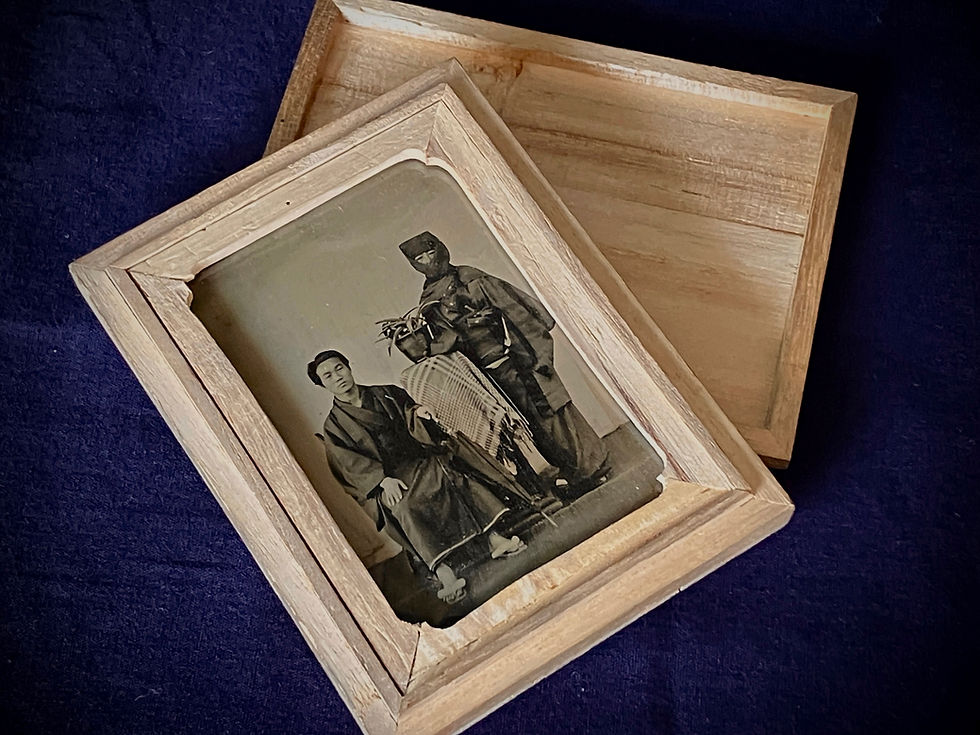The History of Wet Plate Photography in Japan
- esfahanchaihane
- Jan 1, 2024
- 3 min read
Updated: 18 hours ago

The story of photography in Japan begins in 1848, when the daguerreotype—the world’s first practical photographic process—arrived in Nagasaki from the Netherlands.Invented by Louis Daguerre in France, the daguerreotype used a silver-plated copper sheet sensitized with iodine vapor. The plate was exposed in a camera, developed with mercury vapor, and fixed in a sodium thiosulfate solution, known as hypo.
When the French government released the process to the public in 1839, equipment and manuals quickly spread throughout Europe and America, and portrait studios appeared almost overnight.In Japan, however, the record is sparse. Only one known daguerreotype image is believed to remain—a portrait of Shimazu Nariakira, a feudal lord of the Satsuma Domain.
The Arrival of the Wet Plate Collodion Process
Just a few years later, in 1851, the wet plate collodion process was invented by the British photographer Frederick Scott Archer.By around 1854, this new and more practical technique had found its way to Japan, entering through the open ports of Nagasaki, Yokohama, and Hakodate.
Because the wet plate process arrived so soon after the daguerreotype, many historians consider it the true beginning of photography in Japan—a moment when the medium shifted from scientific curiosity to artistic and social practice.
The Pioneers: Hikoma Ueno and Renjō Shimooka
Two men are widely regarded as the founders of Japanese photography: Hikoma Ueno in Nagasaki and Renjō Shimooka in Yokohama.Both opened studios in 1862, trained numerous students, and left a deep mark on the cultural life of late Edo and early Meiji Japan.
Hikoma Ueno’s Experiments
Ueno first learned about the wet plate process from the Dutch physician Pompe van Meerdervoort, who was teaching Western medicine at the Nagasaki Naval Training Center.Alongside fellow student Kuwajirō Horie, Ueno began experimenting with photography using what little information and materials they could gather.
At that time, equipment and chemicals were extremely scarce. Yet Ueno’s determination led him to study under Pierre Rossier, a Swiss photographer visiting Japan, whose lessons accelerated his progress dramatically.Before long, Ueno obtained a proper wet plate camera from a Dutch merchant and began traveling to Edo (modern Tokyo) to photograph feudal lords.
He later taught Dutch and chemistry (semmyaku-gaku) at a domain school in Tsu before returning to Nagasaki, where he opened one of Japan’s earliest photographic studios.
Crafting Chemistry from Scratch
Today, wet plate photographers can simply purchase chemicals like collodion and silver nitrate from suppliers.But in the mid-19th century, Ueno and his peers had to make everything by hand.
They produced ammonia from cow bones and potassium cyanide from cow blood.Because beef was rarely eaten in Japan at that time—it was considered a foreign food—Ueno and Horie reportedly snuck into slaughterhouses at night to obtain what they needed.Even silver nitrate was made by dissolving Mexican silver coins in nitric acid.
These early photographers were not just image-makers; they were chemists, craftsmen, and innovators working at the very edge of technology.
Photographing the Shishi: The Patriots of the Bakumatsu Era
Ueno’s studio became a crossroads for travelers, foreigners, and revolutionary thinkers.Many of the Bakumatsu patriots—those who helped usher Japan into the modern era—sat for portraits there.Among them was Ryōma Sakamoto, whose iconic image remains one of the most famous photographs in Japanese history.
In the 1880s, a cabinet-sized portrait cost around 2 yen, roughly 40,000 yen (about 250 USD) in today’s money—a luxury item reserved for the few who could afford it.
The End of the Wet Plate Era
By the late 1870s, a new photographic material—the dry plate—began to appear.Unlike wet plates, which required on-site development and several seconds of exposure, dry plates were more sensitive and could be handled without a portable darkroom.
This innovation transformed photography.Images could be made faster, more conveniently, and by a broader range of people.And so, the luminous, hand-crafted beauty of wet plate photography gradually faded from everyday life—only to be rediscovered, generations later, by those who still find magic in the alchemy of light and silver.



